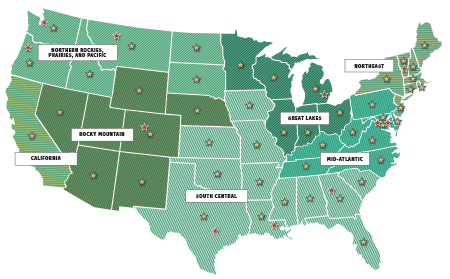Climate change is the greatest existing threat to American wildlife, wild places, and communities around the country. Without action, breeding ground for ducks in the American heartland could dry up, moose in New England could be lost to parasites, forests in the west will burn more frequently and ferociously, and trout streams in Appalachia could become too warm for trout.

Climate change is caused by pollution from harmful gases released by human activity. These gases are heating up our planet at an alarming and unsustainable rate. This damage is not merely the result of our over-reliance on fossil fuels, but also because of poor land use and agricultural practices that release warming gases into the atmosphere. Fortunately, if we act quickly, there are solutions that will help us avoid the most calamitous impacts of climate change.
The National Wildlife Federation is working to make these solutions happen in order to ensure a stable environment for future generations. Specifically, the National Wildlife Federation is:
In addition to this, the National Wildlife Federation runs programs that enable individuals to make a difference through projects, like Gardening for Climate Change, and educate children, like our Eco-Schools USA program.
The National Wildlife Federation aim to prevent the causes, mitigate the impacts, and adapt to the fluctuations of a changing climate.
Human-caused climate change is the result of harmful gases being released into the atmosphere. Climate altering gases primarily come in the form of carbon dioxide, which is released when we burn fossil fuels, and when land-use practices, such as tilling, expose stored carbon and microbes in the soil to oxygen. Pollution also comes from the release of other greenhouse gases, including methane (CH4), nitrous oxide (N2O), and fluorinated gases like hydrofluorocarbons, which build up in the atmosphere and trap heat on our planet. These gases have led to public health problems, haze, more frequent and extreme weather, increasing incidence of drought and fire, ecosystem disruption, and changes in species distribution and migration patterns. It is of critical importance to wildlife that we reduce these harmful emissions as quickly as possible.
The Problem: Climate change is largely caused by human-induced carbon pollution and it poses a significant threat to wildlife, habitats, and many of our communities. Without swift action to reduce these harmful emissions habitats will be lost and up to half of all species may face extinction. For instance, breeding grounds for ducks in the heartland could dry up, moose in New England could be lost to parasites, forests in the west will burn more frequently and ferociously, and trout streams in Appalachia could warm to an inhospitable degree.
Carbon pollution comes from a variety of sectors. Burning fossil fuel to generate electricity and provide transportation is the cause of most of our emissions, but land-use practices that allow carbon to escape into the atmosphere can also result in substantial emissions. The National Wildlife Federation aims to protect wildlife and ensure a stable climate for future generations.
Policy Options: Fortunately, there are solutions. By transitioning to cleaner sources of energy and changing agricultural and forestry practices we can slow climate change and benefit wildlife. The National Wildlife Federation currently focuses on reducing emissions in four key areas:
Fact Sheet: President Trump's March 28, 2017, Executive Order canceling the U.S. Climate Action Plan
Issue Brief: Climate Change Bites!: The impacts of ticks on wildlife, public health, and outdoor recreation
Climate change is already having profound effect on our wildlife and the habitats they call home. To safeguard wildlife in a warmer world we need to make conservation "climate-smart." Preparing for and coping with current and future climate impacts is an emerging field known as "climate change adaption." The National Wildlife Federation is working closely with federal and state agencies to help conservation managers understand how to incorporate climate adaption into their work in order to carry out climate-smart conservation.
Global deforestation is a significant source of climate change pollution, impacting wildlife and habitat throughout the United States and the world. Evidence is mounting that the loss of forests in South America and Africa can have a direct effect on rainfall and temperature patterns in the United States. Tropical forests, which provide key habitats for migrating species, are especially threatened because they are often cleared for large-scale agriculture to produce ingredients for products we use daily. The National Wildlife Federation develops strategies to help ensure that agricultural production can meet the world's needs without destroying forests or jeopardizing wildlife habitats.
For millions of Americans, gardening is much more than a hobby—it is a passion. Unfortunately, climate change is threatening the gardening experience across the country. However, there are actions that you can take to be part of the solution, even while gardening.
Take the Clean Earth Challenge and help make the planet a happier, healthier place.
Learn MoreA groundbreaking bipartisan bill aims to address the looming wildlife crisis before it's too late, while creating sorely needed jobs.
Read MoreMore than one-third of U.S. fish and wildlife species are at risk of extinction in the coming decades. We're on the ground in seven regions across the country, collaborating with 52 state and territory affiliates to reverse the crisis and ensure wildlife thrive.
